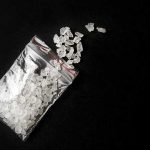Crack cocaine, a highly addictive stimulant drug, looks like small white or off-white rock crystals of varying shapes and sizes. Crack rocks are a potent form of cocaine and the rocks are smoked, rather than snorted or injected.
What Does Crack Look Like?
Crack cocaine looks like small irregularly shaped chunks of white, off-white, or yellowish rocks. Additives, like levamisole or powdered milk, may contribute to differences in color of separate batches of crack cocaine.
Crack cocaine makes a crackling sound when it is smoked, which is where it gets its name. It is more potent than powder cocaine and a small amount of crack can produce a rapid and intense high.
Although you can identify crack by the drug itself, paraphernalia can also be a sign of drug abuse. Crack cocaine smoking may involve crack pipes, lighters, or homemade equipment made of aluminum foil or light bulbs.
How Is Crack Made?
Powder cocaine, known as cocaine hydrochloride, comes from the coca plants of South America. This form of cocaine is a crystalline powder that can be snorted, injected, or rubbed on the gums.
When powder cocaine is combined with baking soda, it frees the base form of cocaine from the salt (hydrochloride) element. This creates a “freebase” form of cocaine that flakes into small rocks that can be smoked.
Effects Of Crack Cocaine
Crack cocaine is a stimulant drug that produces effects similar to cocaine powder. However, these effects occur more intensely but wear off quicker. People may use crack cocaine in binges to maintain the effects of the drug.
Crack cocaine increases levels of dopamine in the brain. Dopamine is a brain chemical associated with mood and motivation. Drug abuse can affect how much dopamine the brain produces, which may lead to more frequent drug use to compensate.
Smoking crack cocaine can cause a brief rush of euphoria, increased energy, and alertness. It may also increase sensitivity to light, sound, and touch.
Short-term side-effects of cocaine also include:
- constricted blood vessels
- dilated pupils
- nausea
- increased body temperature
- high blood pressure
- increased heart rate
Importantly, crack cocaine is a potent drug that affects everyone differently.
While some people may feel more focused when taking stimulants, others may experience an increase in anxiety and paranoia. It can also decrease the desire for food and sleep, which can negatively impact physical and mental health.
Additional dangers of crack cocaine include:
- irregular heart beat
- heart attack
- stroke
- cardiac arrest
- malnutrition
- psychosis
- panic attacks
- unpredictable or violent behavior
Is Crack Cocaine Addictive?
Cocaine is a schedule II controlled substance in the United States, which means it has a high risk of abuse. Long-term crack cocaine use can change the structure and function of the brain, which increases the risk of developing a substance use disorder (SUD).
According to the National Institute on Drug Abuse (NIDA), more than half the people seeking cocaine addiction treatment use multiple substances. This is known as polydrug abuse and increases the risk of long-term health problems and overdose.
Professional addiction treatment centers offer comprehensive care from experienced professionals. Detox, residential treatment, and aftercare programs can help you develop the skills necessary to maintain long-term recovery.
Northeast Addictions Treatment Center offers behavioral therapies and other forms of evidence-based treatment that can help you prevent relapse and improve well-being. If you or a loved one would like to learn more about our treatment programs, please call our helpline today.
Sources
- Drug Enforcement Administration (DEA) — Cocaine Drug Fact Sheet
- National Institute On Drug Abuse (NIDA) — How Is Cocaine Addiction Treated?
- National Institute On Drug Abuse (NIDA) — What Are The Short-Term Effects Of Cocaine Use?
- United Nations Office On Drugs And Crime (UNODC) — Recommended Methods For The Identification And Analysis Of Cocaine In Seized Materials
Written by
Northeast Addition Editorial Team
©2024 Northeast Addition Center | All Rights Reserved
This page does not provide medical advice.






